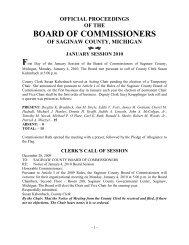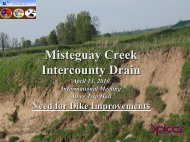The Metropolitan Transportation Planning ... - Saginaw County
The Metropolitan Transportation Planning ... - Saginaw County
The Metropolitan Transportation Planning ... - Saginaw County
Create successful ePaper yourself
Turn your PDF publications into a flip-book with our unique Google optimized e-Paper software.
<strong>The</strong> <strong>Metropolitan</strong> <strong>Transportation</strong> <strong>Planning</strong> Process: Key Issues<br />
What is "smart growth"?<br />
Smart growth is a set of policies and programs designed by local governments to<br />
protect, preserve, and economically develop established communities and natural<br />
and cultural resources. Smart growth encompasses a holistic view of development.<br />
From a transportation perspective, smart growth includes building walkable<br />
communities and providing a variety of transportation choices by integrating land<br />
use planning and transportation planning. Smart growth policies link transportation<br />
projects with desired land use patterns in order to make more efficient use of<br />
infrastructure (assets such as roads, bridges, and equipment) and reduce<br />
environmental impact.<br />
Using a smart-growth approach, an area can consider land use strategies that will<br />
reduce both transportation and environmental problems, and achieve quality-oflife<br />
goals. <strong>The</strong>se land use strategies may include:<br />
●<br />
●<br />
●<br />
●<br />
●<br />
●<br />
●<br />
Site design planning, with an emphasis on pedestrian access and transit<br />
service.<br />
Incentives and bonuses for desired land uses and for developments that<br />
provide desired transportation and land use amenities.<br />
A balance of job growth with housing developments priced and located to<br />
match the needs and incomes of the work force.<br />
Minimum as well as maximum development densities and floor area ratios<br />
that ensure adequate ridership for transit.<br />
Requirements for providing adequate public facilities (i.e., schools, fire and<br />
police protection) commensurate with development, or for attaining a<br />
minimum level of service standards.<br />
Urban growth limited to areas where urban services are already available or<br />
are scheduled.<br />
Consistency between local land use plans and local and regional<br />
transportation plans.<br />
What is the role of the MPO in smart growth?<br />
Smart growth policies are usually developed and mandated at the state (and<br />
sometimes the regional) level. <strong>The</strong> role of the MPO varies according to the authority<br />
and influence it has in regional land use matters.<br />
As the organization that adopts the transportation plan and the TIP, the MPO is able<br />
to influence transportation investments toward improving quality of life, and can<br />
tailor some transportation activities to improve both specific economic<br />
development projects and regional mobility in general. <strong>The</strong> transportation planning<br />
process provides critical input into a regional smart growth strategy. <strong>The</strong><br />
transportation plan, in particular, outlines the vision and goals for transportation<br />
investment, thus incorporating smart growth policies.<br />
Additional sources of information:<br />
A Toolbox for Alleviating Traffic Congestion and Enhancing Mobility, Institute of<br />
<strong>Transportation</strong> Engineers: Washington, D.C., 1997.<br />
Institute of <strong>Transportation</strong> Engineers, "Smart Growth? Sensible Growth? Sustainable<br />
Growth? Balanced Growth? Responsible Growth -- What Are the <strong>Transportation</strong><br />
Needs to Achieve This Growth?" ITE Journal, April 2000.<br />
Apogee Research, Inc. and Greenhorne & O'Mara, Research on the Relationship<br />
Between Economic Development and <strong>Transportation</strong> Investment, National<br />
Cooperative Highway Research Program Report 418, Washington, D.C.:


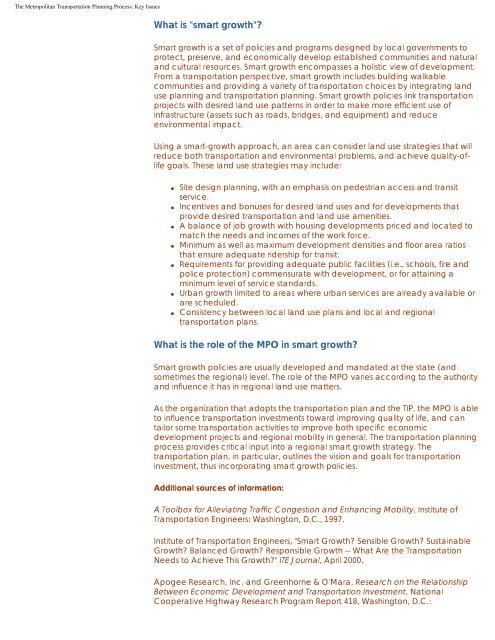
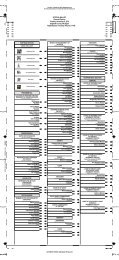
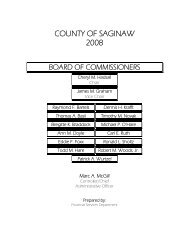
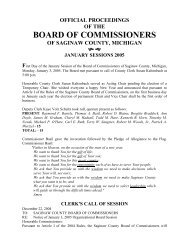
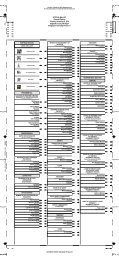

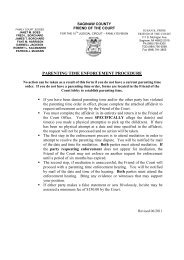
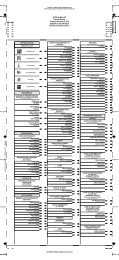


![[ Of Commissioners] - Saginaw County](https://img.yumpu.com/25951211/1/190x245/-of-commissioners-saginaw-county.jpg?quality=85)


